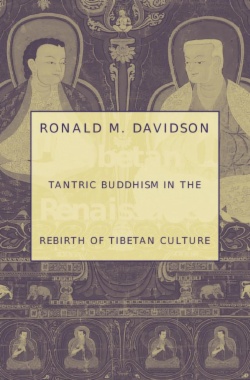How did a society on the edge of collapse and dominated by wandering bands of armed men give way to a vibrant Buddhist culture, led by yogins and scholars? Ronald M. Davidson explores how the translation and spread of esoteric Buddhist texts dramatically shaped Tibetan society and led to its rise as the center of Buddhist culture throughout Asia, replacing India as the perceived source of religious ideology and tradition. During the Tibetan Renaissance (950-1200 C.E.), monks and yogins translated an enormous number of Indian Buddhist texts. They employed the evolving literature and practices of esoteric Buddhism as the basis to reconstruct Tibetan religious, cultural, and political institutions. Many translators achieved the de facto status of feudal lords and while not always loyal to their Buddhist vows, these figures helped solidify political power in the hands of religious authorities and began a process that led to the Dalai Lama's theocracy. Davidson's vivid portraits of the monks, priests, popular preachers, yogins, and aristocratic clans who changed Tibetan society and culture further enhance his perspectives on the tensions and transformations that characterized medieval Tibet.
- Contents
- Preface
- List of Maps, Figures, and Tables
- Pronunciation Guide
- Introduction
- Pakpa and the Mongol Endgame
- Historical Agents in the Renaissance
- The Sakya Paradigm and the Present Work
- Renaissance as a Trope
- 1 Early Medieval India and the Esoteric Rhapsody
- Sociopolitical India in the Medieval Period
- The Buddhist Experience and Institutional Esoteric Buddhism
- The Perfected: Siddhas and the Margins of Society
- Tantric Literature and Ritual
- Naropa the Legend: The Great Pandita Goes Native
- Virupa’s Hagiography: Mr. Ugly Comes to Town
- Hagiography, Lineage, and Transmission
- Conclusion: Emerging Indian Rituals
- 2 The Demise of Dynasty and a Poorly Lit Path
- Good Intentions at the End of the Empire
- Fragmentation: Flight in the Dark, Light in the Tombs
- Religion on an Uneven Path
- Clans in the Tenth and Eleventh Centuries
- Conclusion: A Change of Fortune in Tibet
- 3 Renaissance and Reformation: The Eastern Vinaya Monks
- In Pursuit of Virtue in the Northeast
- To Central Tibet on a Mission from Buddha
- Conflict on the Roof of the World
- West Tibet and the Kadampa Connection
- History as the Victory of Great Ideas and Good Organization
- Conclusion: A Tradition Under the Imperial Shadow
- 4 Translators as the New Aristocracy
- Mantrins and Motivation for New Translations
- Trans-Himalayan Coronation
- The Curious Career of Ralo Dorjé-drak
- Tantric Action in Practice
- The Mysterious Master Marpa
- Gray Texts, New Translation Apocrypha, and Zhama Chökyi Gyelpo
- The Invention of Neoconservative Orthodoxy
- The Cult and Culture of Knowledge
- Conclusion: The Translator as Prometheus
- 5 Drokmi: The Doyen of Central Tibetan Translators
- The Nomadic Translator
- Drokmi in India
- An Eventual Return to Tibet
- The Indian Contingent: Gayadhara and the Other Panditas
- Drokmi’s Work and the Origin of the Root Text of the *Margaphala
- The Contents of the Root Text of the *Margaphala
- The Eight Subsidiary Cycles of Practice
- Drokmi’s Other Translations
- Conclusion: Fallible Characters with Literary Genius
- 6 Treasure Texts, the Imperial Legacy, and the Great Perfection
- Buried Treasures Amid the Rubble of Empire
- Guarded by Spirits: The Hidden Imperial Person
- Terma in the Eleventh and Twelfth Centuries
- Give Me That Old-Time Religion
- The Alternative Cult of Knowledge: Rig-pa
- Conclusion: The Absent Imperium as an Eternal Treasure
- 7 The Late Eleventh Century: From Esoteric Lineages to Clan Temples
- The Little Black Acarya: Padampa and His Zhiché
- Popular Expressions and a Zeal to Spread the Message
- The Late-Eleventh-Century Intellectual Efflorescence
- Drokmi’s Legacy and the Next Generation
- The Khön Clan Mythology and Sakya Beginnings as a Clan Temple
- Conclusion: New Beginnings in the Wake of the Translators
- 8 The Early Twelfth Century: A Confident Tibetan Buddhism
- The Kadampa Intellectual Community
- The Kalacakra Comes of Age
- Gampopa and the Kagyüpa Efflorescence
- The Ladies Machik Expand the Repertoire: Chö and the Zhama Lamdré
- Sachen Kunga Nyingpo: Sakya Crisis and Continuity
- Bari-lotsawa and the Ritual Imperative
- Sachen and the Eleven Commentaries
- Sachen’s Other Literary Legacy
- The Virupa Visions and the Khön Short Transmission
- Conclusion: Tibetans Reformulate Their Religion
- 9 The Late Twelfth to Early Thirteenth Century: Ethical Crises, International Prestige, and Institutional Maturation
- Conflict and Crazies in the Late Twelfth Century
- Kagyüpa Missionary Activity and the Tanguts
- Sachen’s Disciples, Sons, and the Continuity of Tradition
- Perpetuating the Khön Line: Sönam Tsémo
- Drakpa Gyeltsen and the Sakya Institution
- Dreams, Revelation, and Death
- The Brothers as Complementary Littérateurs and the Domestication of the Lamdré
- Esoteric Clarification and the Integration of the Exegetical System
- The Buddhist Context and Early Sakya Pedagogical Works
- Conclusion: A Secure Source of Buddhist Spirituality
- 10 Conclusion and Epilogue: The Victory of the Clan Structure, Late Tantric Buddhism, and the Neoconservative Vision
- Notes
- Glossary
- Tibetan Orthographic Equivalents
- Appendix 1: Eastern Vinaya Temples, Cave Temples, and Residences in the Mid-Eleventh Century
- Appendix 2: Translation and Text of the Root Text of the *Margaphala
- Appendix 3: A Concordance of Early Commentaries on the Root Text of the *Margaphala
- Notes to Appendices
- Notes to the Edition
- Abbreviations
- Bibliography
- Index

